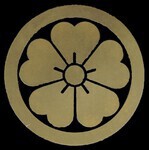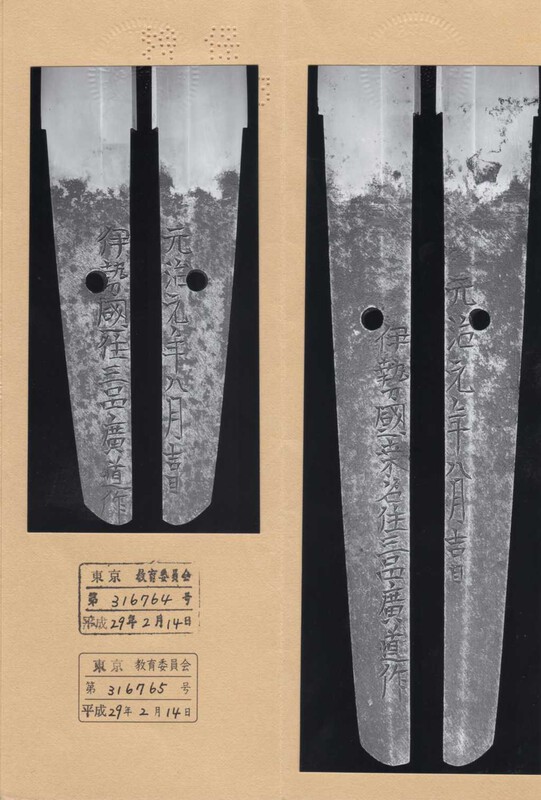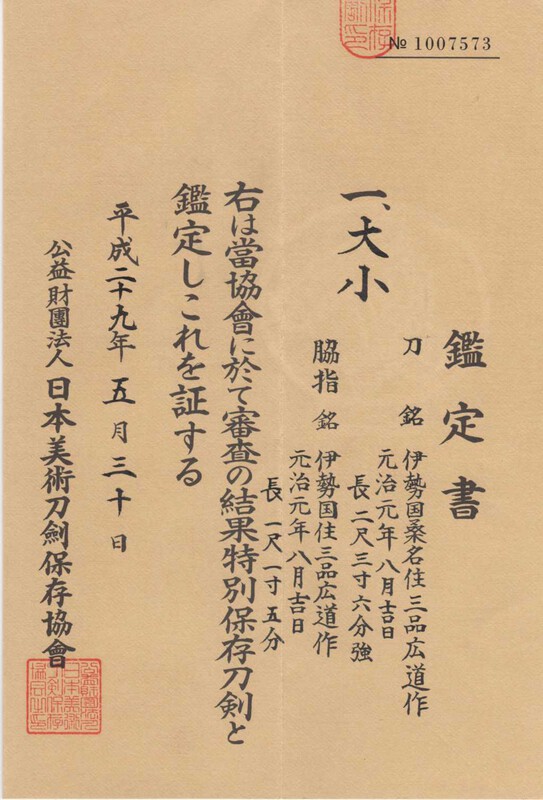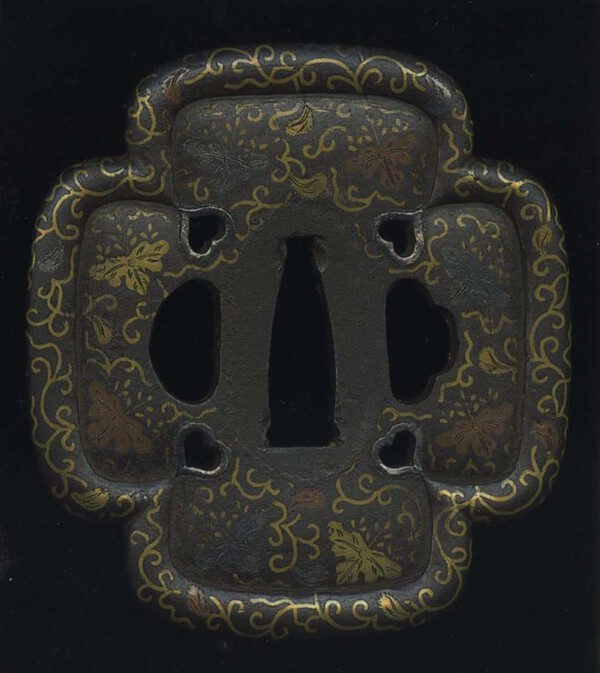-
Posts
3,242 -
Joined
-
Days Won
99
Content Type
Profiles
Forums
Events
Store
Downloads
Gallery
Everything posted by Guido
-
Some background info on the katana-kaji: Mishina Hiromichi 三品廣道, real name Mishina Tōemon 三品藤右衛門, was a smith who belonged to the Mishina-ha 三品派. He was either the son or the younger brother of the 9‘th generation Mutsu no Kami Daidō 九代目陸奥守大道, records are somewhat conflicting. He worked mainly in Ise province 伊勢国 , but also in Iga 伊賀国. He was active at least from Kaei to Keiō (1848 - 1868), and was succeeded by his first son Mishina Hanbei Hirofusa 三品半兵衛廣房, and second son Mishina Tōkuro Hiromichi 三品藤九郎廣道. At that time the Kuwana domain 桑名藩 was ruled by Matsudaira Sadaaki 松平定敬, a descendant of Tokugawa Ieyasu's brother. Sadaaki was the Tokugawa shōgunate's last Kyōto-shoshidai 京都所司代 (the shōgun's deputy in the Kyōto region, responsible for maintaining relations between the shōgunate and the imperial court, and controlling access of the daimyō to the court) until 1864, the year these swords were made. And finally, here’s the restored wakizashi-koshirae: It’s a pity that the katana-koshirae got lost, but at least having a koshirae (sans some fittings) that is contemporary - and even original - to the blade isn’t something one encounters too often. Last but not least: a huge thanks goes to Bob Hughes, who’s not only a good friend, but who also can make the impossible possible for you. He certainly doesn’t need yet another endorsement, but I do that gladly anyhow. Quite a few items in my collection come from him, and he also sold some for me when I felt the itch to upgrade. Also, his prices are *very* fair and competitive! I hope you enjoyed going with me on this little sword journey, all comments are welcome. If you own a “true” daishō, please post it here. Regarding daishō-koshirae, I’ll open another thread in the tōsōgu forum soon.
- 33 replies
-
- 21
-

-

-
Without further ado, here are the swords: Dai signed 伊勢国桑名住三品廣道作 Ise (no) Kuni Kuwana jū Mishina Hiromichi saku Shō signed 伊勢国住三品廣道作 Ise (no) Kuni jū Mishina Hiromichi saku Both are dated 元治元年八月吉日 Genji gannen hachigatsu kichijitsu (a lucky day in August of 1864) The swords are shinogi-zuruki, low iori-mune. Sori, kasane and mihaba are moderate, strong hira-niku, chū-kissaki. Fine ko-itame-hada, the shinogi-ji shows masame. The hamon is ko-nie-deki gunome-midare with a bright nioiguchi; ashi, sunagashi, and kinsen. Profuse ji-nie, forming jubashiri towards the shinogi. Typical Mishina-bōshi and -yakidashi. Ubu-nakago, ōsujikai with keshō-yasurime, ha-agari-kurijiri, one mekugi-ana. Nagasa: 71.7 cm (dai) / 34.9 cm (shō) Sori: 1.2 cm (dai) / 0.6 cm (shō) Since sword photography and drawing oshigata isn’t exactly my forte, I had Mr. Tsuruta of Aoi Art do that for me:
- 33 replies
-
- 15
-

-
I’m usually not much of a show-and-tell guy, but being more or less confined to my apartment recently, my mounting boredom finally drove me to make an exception. Or, more candidly: facing the choice over the Easter weekend between filing my tax return, another day of binge-watching, starting drinking at 9:30 AM, and writing something up for the NMB, my liver and brain convinced me to opt for the latter . When I started collecting Japanese swords more than forty years ago, I set my sights on a daishō as the ultimate goal – after all, it’s often considered the epitome of samurai culture. But progressing in my studies, and losing quite a few romantic notions along the way, I realized that it wasn’t really that important to me anymore. My collecting focus had shifted to Sō-den kotō, and there are simply no “true” daishō from that period: some are from the shintō period, but the vast majority is from the shinshintō period – and all of them are hard to find anyhow, being few and far between. I don’t want to go too much into what constitutes a true daishō, Darcy Brockbank already explained that in one of his excellent blog entries: https://blog.yuhindo.com/daisho/; he calls it jokingly “the holy grail for sword collectors”, but considering its rarity, this isn’t too far from the truth. To summarize: the swords have to be obviously made as a pair in regard to the deki, carry the same date, have consecutive tōrokushō numbers, and both blades are on one kanteisho. Other than swords and tsuba, I also collect and research koshirae, and over the years was able to add five daishō-koshirae to my collection; however, acquiring the blades themselves seemed to remain as elusive as ever. During my decades of collecting, I only saw a very few daishō up for sale, and those that were of a quality that I found desirable, were expectedly way beyond of what I was able or willing to pay. Well, while going on a road trip to the North of Honshū with Robert Hughes about 1 ½ years ago, he told me that he had bought a daishō at a dealers auction the day before – which immediately piqued my curiosity. About a week later, I was able to inspect the swords, and really took to them. However, the katana came in a very old shirasaya (saya only), and the wakizashi in a koshirae that had the ito cut off, and was stripped of tsuba, kōgai, kozuka, and menuki. Both blades needed a polish, as well as new shirasaya and habaki, but already had tokuho papers. And there it was, my new project to bring back this daishō to its former glory, kind of making an old, almost forgotten dream come true . Bob even took the legwork out of getting the swords to the involved craftsmen for me, so I concentrated on having the wakizashi-koshirae restored. (Btw, the polishing was done by Ikeda Nagamasa.)
- 33 replies
-
- 21
-

-

-
I feel you, Ken - being all day long at home, I too tend to drink too much ...
-

AOI Art Sword Videos on Youtube
Guido replied to Lance's topic in General Nihonto Related Discussion
-
If I have a rotten tooth, I can either a) have a root canal done or b) keep it as it is and have it preserved, because it’s part of my body’s history, and future forensic dentists can learn a great deal from it. Also, an implant would be completely inappropriate, because it has no soul.
-

AOI Art Sword Videos on Youtube
Guido replied to Lance's topic in General Nihonto Related Discussion
If it’s the same deki, yes. If not, a comparison wouldn’t make any sense. -

AOI Art Sword Videos on Youtube
Guido replied to Lance's topic in General Nihonto Related Discussion
If that was the case, one of the swords didn’t receive the proper polish - I don’t think Darcy would go for anything like that ... -

AOI Art Sword Videos on Youtube
Guido replied to Lance's topic in General Nihonto Related Discussion
I can provide you with this opportunity - all of my swords were polished by top notch togishi, two of them even by a living national treasure. But be careful what you’re asking for, it may spoil your eyes forever. -

AOI Art Sword Videos on Youtube
Guido replied to Lance's topic in General Nihonto Related Discussion
You’re already the second one recently who thinks that Piers stole my account. -

AOI Art Sword Videos on Youtube
Guido replied to Lance's topic in General Nihonto Related Discussion
George, you seem to perceive hadori as some recent, mindless fashion gimmick. Hadori was used at least from the mid-Edo period on according to old records, and possibly even earlier; I hardly would call this “a current trend”. Sashikomi, of course, shows much better in photos, but that’s about all you’ll see from a close distance as well, while hadori needs to be seen in hand, and rewards one with a much clearer view of all the fine details. Also, a polish lasts not forever, and after years and years of using uchiko - which is powdered polishing stone - hadori tends to fade, and at first glance appears as sashikomi; this is especially true when it comes to WWII swords that never received a proper polish in the first place. -
IMO neither ishimeji nor gamahada, but tsuchimeji.
-

AOI Art Sword Videos on Youtube
Guido replied to Lance's topic in General Nihonto Related Discussion
It isn’t gone at all, but it also isn’t something that works on each and every sword; actually, it only makes sense on a sword with a very tight nioiguchi and no hataraki. -
And another statement by the accomplished tsukamaki-shi Iiyama Takashi: Koga Hans has been featured in various media. Among them, was an article saying that he trained at my place, etc. So, I requested a correction to the WEB page because it was incorrect. They corrected the article to say that he learned in Kameari. He paid me for a few months tuition and I only taught him some basics. Additionally, he cancelled lessons three times without notice. So, I stopped teaching and told him not to come anymore. Therefore, he must have continued to do it self taught. Of course, he can teach himself if he wants. However, I must say clearly that I am not his teacher. He doesn’t want to be told that. I think that he has been using my name to make people think he is properly trained to procure work. He is a nuisance.
-

Swords on Exhibit - Oiled(?)
Guido replied to EastCoast's topic in General Nihonto Related Discussion
Ken, the pics are taken at an angle, and the real nakago is visible behind the description boards ... -
Where is the red? Older licenses don’t have the seal in the upper right corner (and the serial number) in red, but the one in the lower left always was and still is ...
-
大川一郎 = Ōgawa Ichirō (but that doesn’t make it less fake).
-
Sangokushi, the Tale of the Three Kingdoms - a famous Chinese story.
-
Or Sōten?
-
Unfortunately not at the moment - it‘s with Robert Hughes, whom I bought it from, and he‘ll submit it for tokuho next week.
-
Well, the tsuba I posted is papered to Washida, so its seems highly likely it is ...
-
What Tom said, Washida. My most recent acquisition (in fact so recent that I even haven't paid for it yet) is almost a twin.
-
“I felt it was a pandemic long before it was called a pandemic.” Sorry, but you made it way too easy












